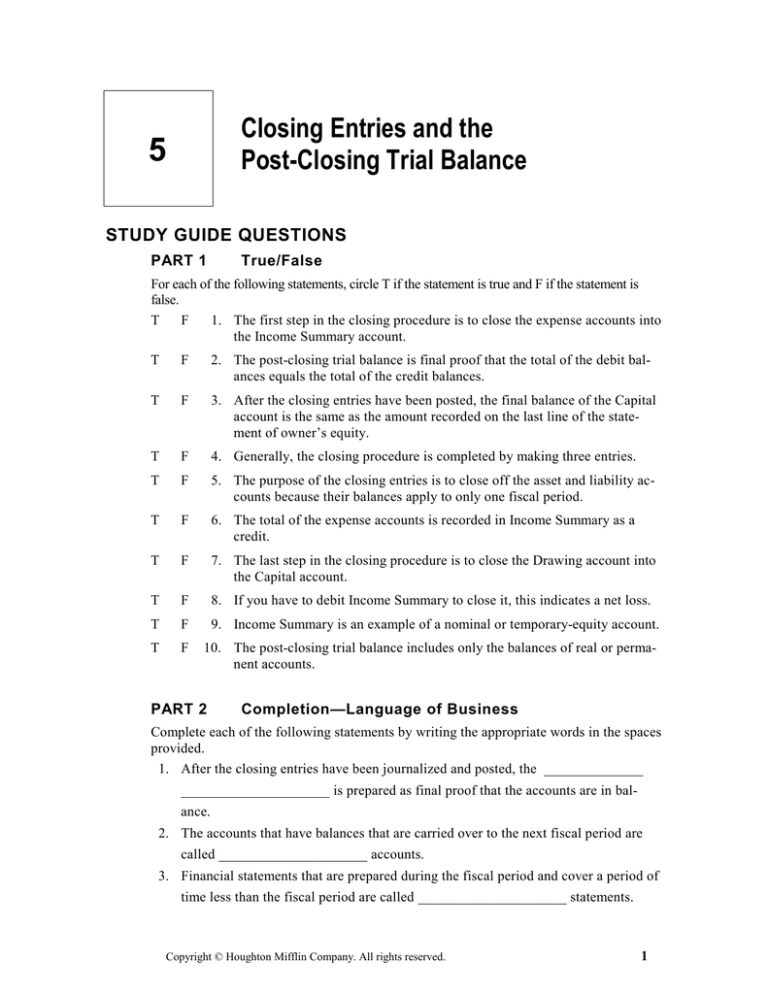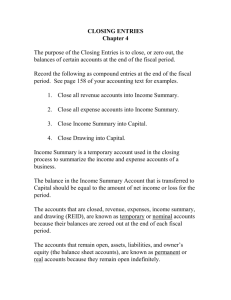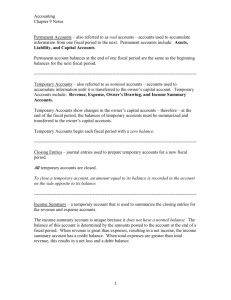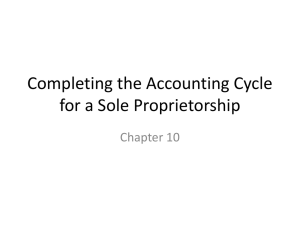
Closing Entries and the
Post-Closing Trial Balance
5
STUDY GUIDE QUESTIONS
PART 1
True/False
For each of the following statements, circle T if the statement is true and F if the statement is
false.
T
F
1. The first step in the closing procedure is to close the expense accounts into
the Income Summary account.
T
F
2. The post-closing trial balance is final proof that the total of the debit balances equals the total of the credit balances.
T
F
3. After the closing entries have been posted, the final balance of the Capital
account is the same as the amount recorded on the last line of the statement of owner’s equity.
T
F
4. Generally, the closing procedure is completed by making three entries.
T
F
5. The purpose of the closing entries is to close off the asset and liability accounts because their balances apply to only one fiscal period.
T
F
6. The total of the expense accounts is recorded in Income Summary as a
credit.
T
F
7. The last step in the closing procedure is to close the Drawing account into
the Capital account.
T
F
8. If you have to debit Income Summary to close it, this indicates a net loss.
T
F
9. Income Summary is an example of a nominal or temporary-equity account.
T
F
10. The post-closing trial balance includes only the balances of real or permanent accounts.
PART 2
Completion—Language of Business
Complete each of the following statements by writing the appropriate words in the spaces
provided.
1. After the closing entries have been journalized and posted, the ______________
_____________________ is prepared as final proof that the accounts are in balance.
2. The accounts that have balances that are carried over to the next fiscal period are
called _____________________ accounts.
3. Financial statements that are prepared during the fiscal period and cover a period of
time less than the fiscal period are called _____________________ statements.
Copyright © Houghton Mifflin Company. All rights reserved.
1
4. The _____________________ account is brought into existence to have a debit and
credit for each closing entry.
5. A journal entry that is made to clear an account or make the balance of that account
equal to zero is called a(n) _____________________ entry.
6. The _____________________ accounts apply to only one fiscal period and are
closed at the end of the fiscal period.
7. An accounting basis under which revenue is recorded only when it is earned and
expenses are recorded only when they are incurred is called the
__________________.
8. The _____________________ is an accounting basis under which revenue is recorded
only when it is received in cash and most expenses are recorded only when they are paid
in cash. Expenses to be counted that are not paid in cash include Depreciation Expense
and Insurance Expense.
PART 3
Closing Entries
Using the following list of account titles, determine the account titles to be debited and
credited for the closing entries below.
a. Rent Expense
b. Service Income
1.
2.
3.
4.
c. L. Drew, Drawing
d. Income Summary
Close out the balances of the revenue account.
Close out the balances of the expense accounts.
Close out the amount of the net income for the period.
Close out the balance of the Drawing account.
Copyright © Houghton Mifflin Company. All rights reserved.
e. L. Drew, Capital
f. Wages Expense
Debit
_______
_______
_______
_______
Credit
_______
_______
_______
_______
2
PART 4
Posting Closing Entries
After the first closing entries have been journalized and posted, the remaining accounts
are shown below in T account form. Based on the T accounts, answer the following questions.
Income Summary
Debit
46,000
Credit
41,000
J. See, Capital
Debit
Credit
Bal. 150,000
J. See, Drawing
Debit
Bal. 22,000
Credit
1. The amount of the total revenue is $_______________.
2. The amount of the total expenses is $_______________.
3. The amount of net income or net loss is $_______________.
4. The amount of the total withdrawals is $_______________.
5. The entry to close Income Summary is a debit to ______________ and a credit to
________________.
6. The entry to close J. See, Drawing, is a debit to _______________ and a credit to
________________.
7. The amount of the increase or decrease is capital for the period is $_____________.
8. The ending balance of J. See, Capital, is $_______________.
Copyright © Houghton Mifflin Company. All rights reserved.
3






